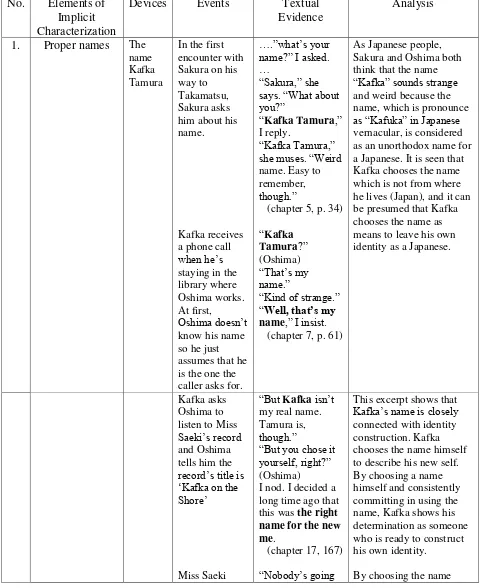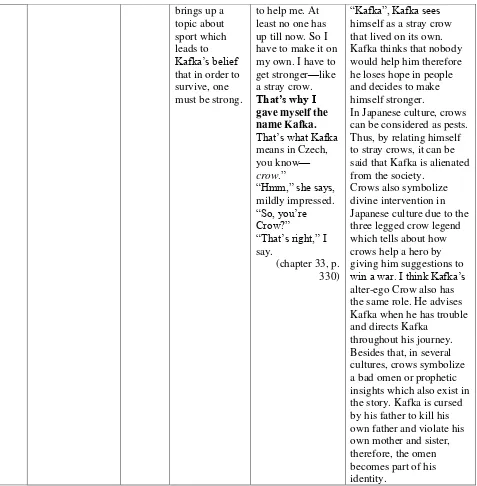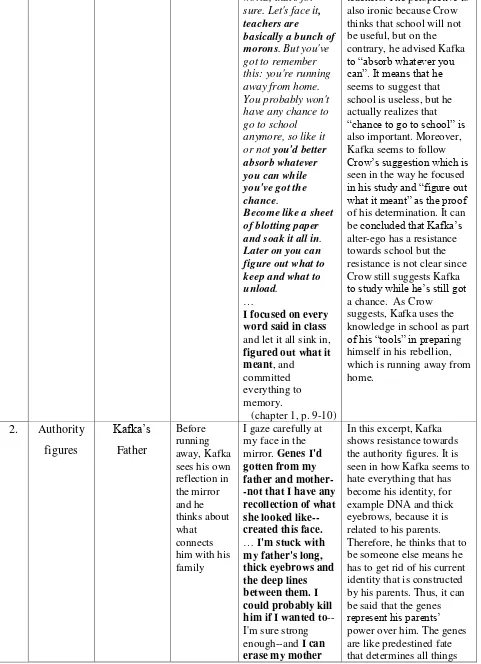CHAPTER III
RESEARCH METHODOLOGY
This chapter focuses on the research methodology which includes the explanation
regarding the method applied in the study. It revolves around the research design,
research question, research procedures, data presentation, and synopsis of the
novel.
3.1. Research Design
This study will use a descriptive qualitative method that will involve a critical
analysis which seeks answer to the questions by examining various aspects of the
novel (Sandelowski, 1991; Riessman, 1993). As Creswell (2003) suggests, the
data which are in the form of words, phrases, and sentences are selected as textual
evidences to be reported in a subjective way.
The principle of qualitative research emphasizes that every finding must
be based on data; therefore findings become more valid before stated as a theory
(Alwasilah, 2002). In addition, according to Hancock (2002), the data of
qualitative method are used to develop the theories that people used to
comprehend an issue or subject in a study. Hence, the data that are collected in
this study are used to elaborate the concepts and theories that have been
mentioned and explained in the previous chapter regarding the theoretical
framework.
Therefore, this approach was suitable for this study because it helped to
discover and explore the identity issue in
Kafka on the Shore
.
3.2. Research Question
This study focuses on the issue of identity of the main protagonist, Kafka Tamura,
in
Kafka on the Shore
to answer this following question:
How is Kafka‟s quest
of constructing an identity depicted in the
3.3. Research Procedure
The procedure of the analysis of the identity construction in
Kafka on the Shore
revolves in at least four steps.
The first step is doing close reading to
Kafka on the Shore
and paying
attention to three main points which will be analyzed, they are: characterization,
conflicts, and young adult issue. The results of the close reading, which are
presented in the form of textual evidence, are collected and categorized into the
three main points by using tables. The function of the tables is to make the process
of analysis easier.
The second
step is determining Kafka‟s characterization by using
Nikolajeva
‟
s (1998) theory on character and characterization to see the description
of Kafka by implementing the mode of presentation of implicit characterization.
This characterization will be the reference to Kafka‟s character development
throughout the story.
The third step is interpreting and analyzing some selected conflicts by
implementin
g Trites‟s (2000) theoretical perspective on
identity formation in
young adult literature, and the analysis focuses on the contribution of power and
repression in constructing an identity. This step will investigate the institutional
discourse, figures of authority, sex and sexuality, and death in
Kafka on the Shore
.
Lastly, after the analysis is conducted, conclusion will be drawn to see
how identity construction is addressed in the novel, and whether or not Kafka has
successfully grown.
3.4. Data Presentation
The data are presented in the form of table to show the embedded issue regarding
identity construction, the events in which the issue occurs, the textual evidence to
support the interpretation, and the analysis.
Table 3.1. Characterization Analysis
No.
Elements of
Implicit
Characterization
Devices
Events
Textual
Evidence
encounter with Sakura on his way to Takamatsu, Sakura asks him about his name.Kafka receives a phone call when he‟s staying in the library where Oshima works. At first,
Oshima doesn‟t know his name so he just assumes that he is the one the caller asks for.
….”what‟s your name?” I asked. …
“Sakura,” she says. “What about you?”
“Kafka Tamura,” I reply.
“Kafka Tamura,” she muses. “Weird name. Easy to
“Kind of strange.”
“Well, that’s my
name,” I insist. (chapter 7, p. 61)
As Japanese people, Sakura and Oshima both think that the name “Kafka” sounds strange and weird because the name, which is pronounce as “Kafuka” in Japanese vernacular, is considered as an unorthodox name for a Japanese. It is seen that Kafka chooses the name which is not from where he lives (Japan), and it can be presumed that Kafka chooses the name as means to leave his own identity as a Japanese.
Kafka asks Oshima to listen to Miss Saeki‟s record and Oshima tells him the record‟s title is „Kafka on the Shore‟
Miss Saeki
“But Kafkaisn‟t my real name. Tamura is, though.”
“But you chose it yourself, right?” (Oshima)
I nod. I decided a long time ago that this was the right name for the new me.
(chapter 17, 167)
“Nobody‟s going
This excerpt shows that Kafka‟s name is closely connected with identity construction. Kafka chooses the name himself to describe his new self. By choosing a name himself and consistently committing in using the name, Kafka shows his determination as someone who is ready to construct his own identity.
brings up a topic about sport which leads to Kafka‟s belief that in order to survive, one must be strong.
to help me. At least no one has up till now. So I have to make it on my own. I have to get stronger—like a stray crow. That’s why I gave myself the name Kafka. That‟s what Kafka means in Czech, you know—
crow.”
“Hmm,” she says, mildly impressed. “So, you‟re
“Kafka”, Kafka sees himself as a stray crow that lived on its own. Kafka thinks that nobody would help him therefore he loses hope in people and decides to make himself stronger.
In Japanese culture, crows can be considered as pests. Thus, by relating himself to stray crows, it can be said that Kafka is alienated from the society.
Crows also symbolize divine intervention in Japanese culture due to the three legged crow legend which tells about how crows help a hero by giving him suggestions to win a war. I think Kafka‟s alter-ego Crow also has the same role. He advises Kafka when he has trouble and directs Kafka
throughout his journey. Besides that, in several cultures, crows symbolize a bad omen or prophetic insights which also exist in the story. Kafka is cursed by his father to kill his own father and violate his own mother and sister, therefore, the omen becomes part of his identity.
Table 3.2.
Kafka’s
Quest of Identity Analysis
No. YAL Issue
Contributing
Characters/
Elements
Description
of Events
Textual Evidence
Analysis
1.
Insitutional
issue
School Kafka tells about his school life
The facts and techniques or whatever they teach you in class isn't going to be very useful in the real
world, that's for sure. Let's face it, teachers are
basically a bunch of morons. But you've got to remember this: you're running away from home. You probably won't have any chance to go to school anymore, so like it or not you'd better absorb whatever you can while you've got the chance.
Become like a sheet of blotting paper and soak it all in.
Later on you can figure out what to keep and what to unload.
…
I focused on every word said in class and let it all sink in, figured out what it meant, and
committed everything to memory.
(chapter 1, p. 9-10)
teachers. The perspective is also ironic because Crow thinks that school will not be useful, but on the contrary, he advised Kafka to “absorb whatever you can”. It means that he seems to suggest that school is useless, but he actually realizes that “chance to go to school” is also important. Moreover, Kafka seems to follow Crow‟s suggestion which is seen in the way he focused in his study and “figure out what it meant” as the proof of his determination. It can be concluded that Kafka‟s alter-ego has a resistance towards school but the resistance is not clear since Crow still suggests Kafka to study while he‟s still got a chance. As Crow
suggests, Kafka uses the knowledge in school as part of his “tools” in preparing himself in his rebellion, which is running away from home. away, Kafka sees his own reflection in the mirror and he thinks about what connects him with his family
I gaze carefully at my face in the mirror. Genes I'd gotten from my father and mother--not that I have any recollection of what she looked like--created this face. … I'm stuck with my father's long, thick eyebrows and the deep lines between them. I could probably kill him if I wanted to --I'm sure strong enough--and I can erase my mother
Kafka tells Oshima about his feeling towards his physical
from my memory. But there's no way to erase the DNA they passed down to me. If I wanted to drive that away I'd have to get rid of me.
(chapter 1, p. 11)
"Oshima, to tell you the unvarnished truth, I don't like the container I'm stuck in. Never have. I hate it, in fact. My face, my hands, my blood, my genes... I hate everything I inherited from my parents. I'd like nothing better than to escape it all, like running away from home."
(chapter 27, p. 278)
about him. They also become a wall for him that blocks him to be free and to construct his own identity.
In this excerpt, Kafka tells Oshima that he feels running away from his home can help him to escape from his parents‟ repression. Oshima talk about Kafka‟s father‟s prophecy
"My father told me there was nothing I could do to escape this fate. That prophecy is like a timing device buried inside my genes, and nothing can ever change it. I will kill my father and be with my mother and sister."
(chapter 21, p. 212)
In this excerpt, Kafka‟s father‟s curse seems to influence Kafka in his perspective towards sex. Kafka is introduced to the concept of sex by his father through his prophecy which insinuates him that he will “be with” his mother and sister.
4.
Death and
grief
Kafka‟s father After spending some time in the woods, Kafka goes back to the library and read the news about his father‟s murder
"Correct me if I'm wrong," Oshima says, "but you don't seem too sad your father was
murdered." "No, I do feel sad. He's my father, after all. But what I really regret is that he didn't die sooner. …”
(chapter 21, p. 209)


